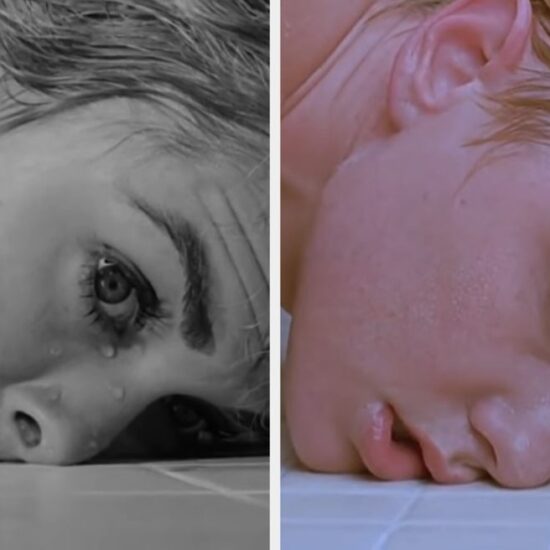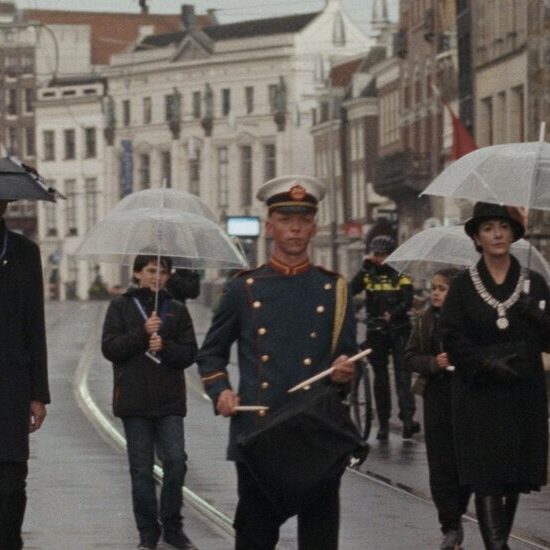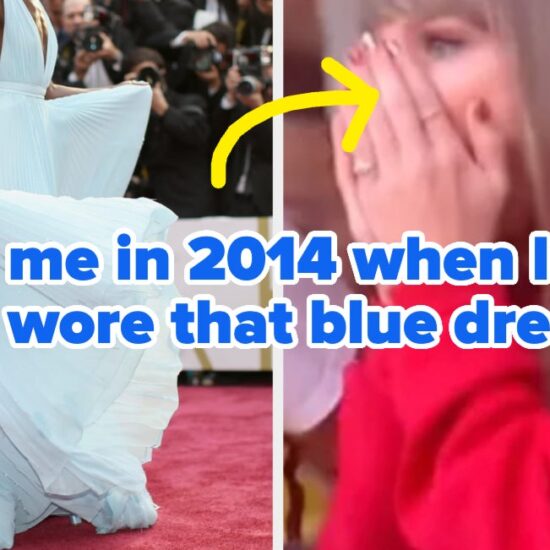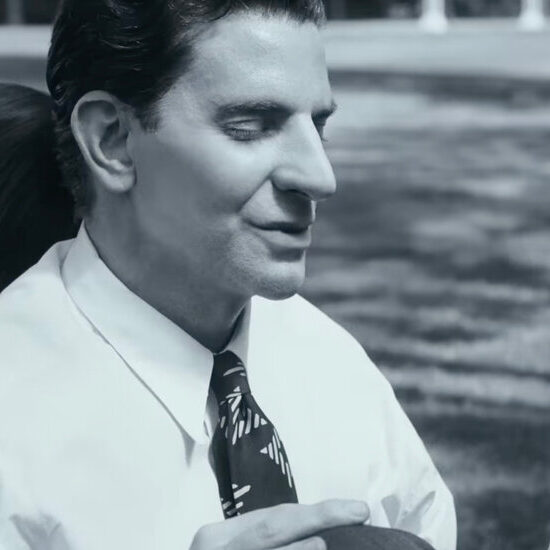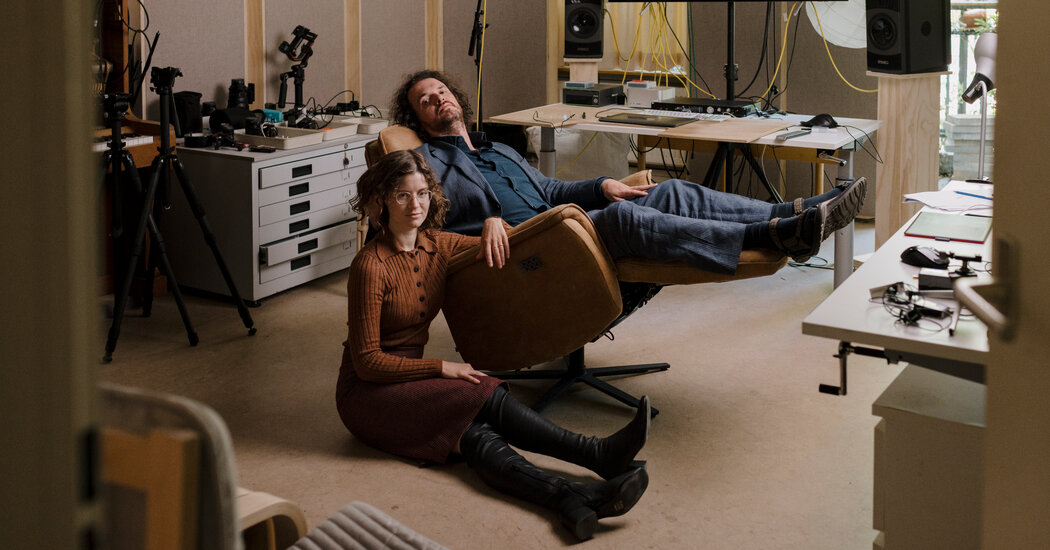
On Saturday night, an eclectic art crowd was gathering outside an industrial garage in Amsterdam East, where Michel Houellebecq, the celebrated French author, was set to speak.
Houellebecq had on May 24 released “A Few Months of My Life,” a new book describing a tumultuous period from October 2022 to March 2023 when he collaborated with a Dutch art collective called KIRAC. Together, they worked on a film, shooting scenes that show the married 67-year-old author making out with young women.
Although Houellebecq had consented to making the film, he later changed his mind and tried to back out. Beginning in February, he brought court cases in France and the Netherlands to stop the movie from being shown. Last month, an Amsterdam judge upheld Houellebecq’s complaint and granted him the right to see a final cut of any re-edited film four weeks before release, giving him a chance to file another action if he doesn’t like what he sees.
In “A Few Months of My Life,” a 94-page autobiographical work, Houellebecq digs deep into his hatred for KIRAC. He names the group’s leader, Stefan Ruitenbeek, only once, describing him as a “pseudo-artist” and “a cockroach with a human face.” Female KIRAC members are referred to as “the sow” and “the turkey.”
According to the organizer of Saturday’s event, Tarik Sadouma, Houellebecq had not come to Amsterdam to promote his new book, but to talk about his work generally. As a condition of his participation, Houellebecq asked Sadouma to bar Ruitenbeek and his cohorts from the event.
Yet just as the audience took its seats inside, Ruitenbeek burst through the door, dressed as a giant brown cockroach, with bobbing antennae and a furry cape. He was trailed by KIRAC members, one wearing a false pig snout, another filming the whole thing.
“I’m here!” cried Ruitenbeek, taking the stage, to a mixture of jeering and cheers. “I’m the cockroach!”
A woman taking tickets tried to wrangle the camera from the cameraman and Sadouma shouted for the intruders to leave. Eventually, Ruitenbeek — pleading, “No violence!” — left with his entourage.
This was the latest episode in an ongoing, surrealistic conflict between KIRAC, a fringe art group that posts its films on YouTube, and Houellebecq, one of the world’s most famous authors.
Was it a performance? A marketing stunt? Or part of a genuine cultural feud? Who could really tell?
KIRAC, an acronym for Keeping It Real Art Critics, is often described as an art collective, but its creative center is Ruitenbeek and Kate Sinha, a writer who is also Ruitenbeek’s life partner. They make films that at first appear to be documentaries, or possibly mockumentaries, typically set in the art world. In them, the boundaries between reality and fiction are often blurred, narratives sometimes conflict and onscreen characters can appear to be playing a game with the truth.
It is also often difficult to discern KIRAC’s political views. In one of its films, the Dutch architect and curator Rem Koolhaas is criticized as “macho” and “patriarchal.” In another, KIRAC seems to decry diversity efforts, arguing that visitors to the Stedelijk Museum, in Amsterdam, were expected to be interested in a retrospective of the artist Zanele Muholi, “only because she is from South Africa, Black and lesbian.” (Muholi now uses they/them pronouns and identifies as nonbinary.)
Seen as provocateurs or pranksters, and sometimes art world trolls, KIRAC’s members often deliver critical monologues directly to the camera, usually in the form of articulate academic analysis from Sinha, or mocking insults from Ruitenbeek.
“In the broadest sense, we’re just trying to make great films, intellectual entertainment,” Sinha said. “I think we are primarily artists, interested in the object we make, which is always the film.”
In a joint interview, Ruitenbeek and Sinha said they developed the concept for the Houellebecq film with the author and shot 600 hours of footage of him, with his contractual consent. Houellebecq only objected when they put together a two-minute trailer for the work in progress, according to Ruitenbeek and Sinha.
In that clip, Ruitenbeek explains that a “honey trip,” or sex holiday, that Houellebecq had planned in Morocco had been canceled because the author feared being kidnapped by Muslim extremists. (Houellebecq has a long history of making critical statements about Islam, and some readers have found Islamophobic sentiments in his books.)
“His wife had spent an entire month arranging prostitutes from Paris, and now everything was falling apart,” Ruitenbeek says in the trailer, in voice-over. He then suggests that there are plenty of young Dutch women in Amsterdam who would have “sex with a famous writer out of curiosity,” and invites the author to visit.
In a French court, Houellebecq argued that the trailer violated his privacy and damaged his image. He asked the court to make KIRAC pull the trailer from all online platforms, remove any mention of his wife arranging prostitutes and pay her damages. The court rejected Houellebecq’s case.
Later, in the Dutch court, Houellebecq argued that KIRAC had violated contract law, and misled him so that he ended up “in a different film than the one originally intended,” according to his Dutch lawyer, Jacqueline Schaap. An appeal judge in that case found for Houellebecq.
The film is still unfinished and continues to evolve, Ruitenbeek said. After Houellebecq left the project, KIRAC filmed in and around the court proceedings, as well as shooting other moments, such as Saturday night’s cockroach show.
Ruitenbeek said he was now rethinking the material, and a final cut may not come for months.
“We started off this project in an open-minded attitude toward each other; we took each other as artists,” Sinha said of the collaboration with Houellebecq. “It feels like he backpedaled and put on a different coat.”
Houellebecq last week agreed to an interview for this article, but pulled out after learning that he would not be shown his quotes before publication. (At the event in Amsterdam, he again declined to comment, claiming that he did not speak English, although he speaks it in the KIRAC film.)
Ruitenbeek’s over-the-top voice-overs and willingness to play a goofball suggest that KIRAC is going for humor. But, often, the subjects of its films don’t find them funny.
“They point fingers at others, but carve out a safe space for themselves’,” said the artist Renzo Martens, who was the focus of an unflattering movie. “From this safe space they are brave enough to cut into other people’s flesh.”
Three Dutch institutions that KIRAC has lambasted — the Stedelijk Museum, the Van Abbe Museum and the Kunstmuseum, in The Hague — declined to comment for this article.
Thijs Lijster, a senior lecturer on the philosophy of art and culture at the University of Groningen, said that there is “something threatening in their ways of going about their work. They have a style of filming, and approaching and talking to people, which is, in a way, rather hostile.”
It is not just KIRAC’s targeting of artists and institutions that has been controversial. Over time, its films have evolved to enter the realm of social commentary, drawing ire from across the political spectrum.
Some viewers saw the group’s 19-minute film “Who’s Afraid of Harvey Weinstein?,” in which Sinha speaks about sexual power dynamics between the American film producer and his rape victims, as dismissive of the #MeToo movement.
A leading art school in Amsterdam, the Gerrit Rietveld Academy, canceled a KIRAC screening after dozens of complaints from students, former students and teachers about statements in the group’s films that they found sexist and racist. The Weinstein movie was championed on a right-wing populist Dutch blog, Geen Stijl. Suddenly, KIRAC became a magnet for conservative followers.
Although Ruitenbeek and Sinha said their personal politics are progressive, KIRAC didn’t disavow the attention, and instead produced a film called “Honeypot.” For that, the group convinced a conservative Dutch philosopher and activist, Sid Lukkassen, to have sex on camera with a left-wing student. The idea was to see if the intimate act would somehow bridge a political gap.
More backlash ensued. When an Amsterdam arts center called De Balie screened “Honeypot,” a feminist collective submitted a petition with more than 1,000 signatures that called the film “a glorification of sexual violence.” The petition’s signers also included the right-wing Dutch politician Paul Cliteur and some of his followers.
“It was interesting that these two sides teamed up against the film for opposite reasons,” said Yoeri Albrecht, De Balie’s director, who did not cancel the event. “I’ve never seen that happen in the more than a decade that I’ve been organizing events here.”
The ambiguity around the group’s motivations only feeds the interest in KIRAC’s work. Many who have been following the Houellebecq affair are unsure whether it’s real or a postmodern KIRAC fiction.
“Everyone is wondering, are they playing a game together?” said Simon Delobel, a curator who teaches at the Royal Academy of Fine Arts, in Ghent, Belgium, where he was introduced to the group’s work by his students. KIRAC and Houellebecq were surely “well aware that it can be interpreted as a stunt,” he added.
Yet Ruitenbeek and Sinha both said their clash with the author was no stunt. They don’t want to be in court with Houellebecq, whom they both described as “a genius.” They just want to be in conversation with him, Sinha said.
Ruitenbeek added that when he showed up at Houellebecq’s talk on Saturday, he thought there was a small chance that everyone would laugh and give each other hugs. He was “very happy the day he went to get the cockroach suit,” Sinha said. “After all these intimidating court cases,” she added, “we were back on our own territory again: making art.”
Léontine Gallois contributed reporting from Paris.








